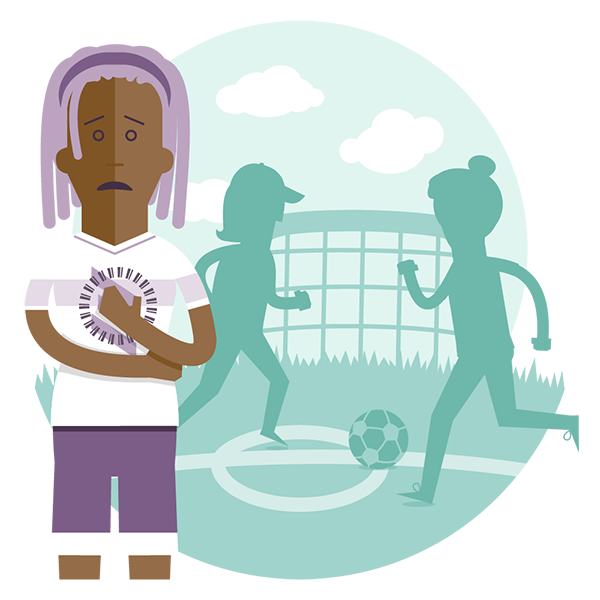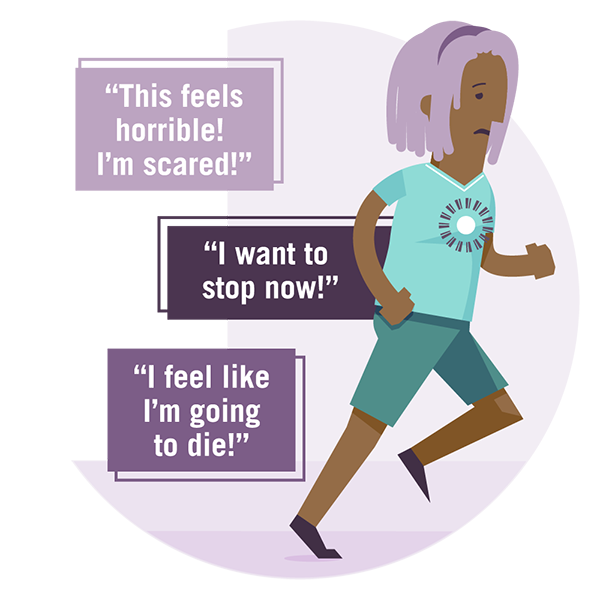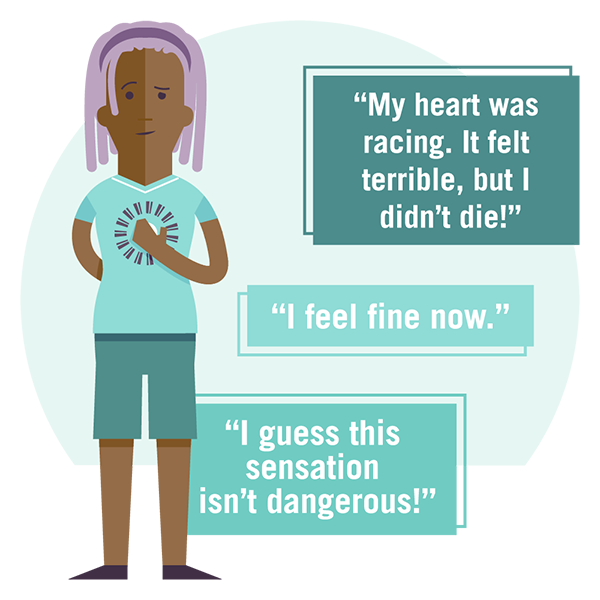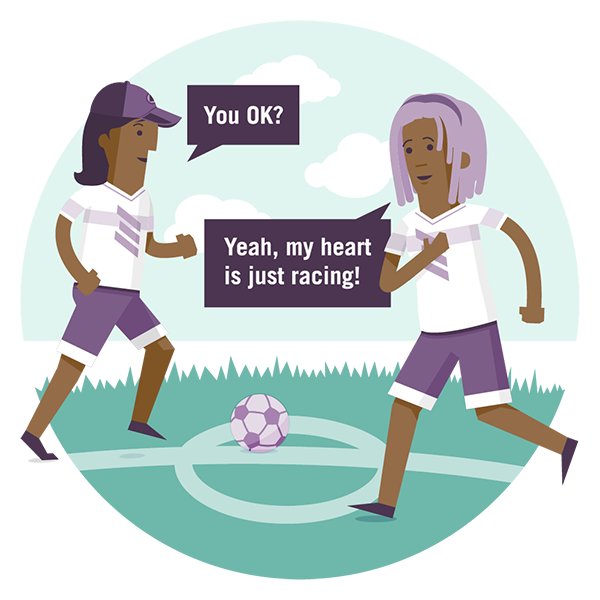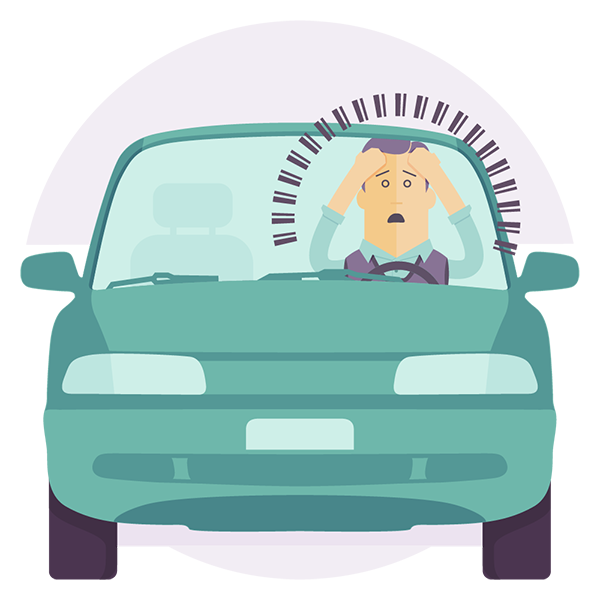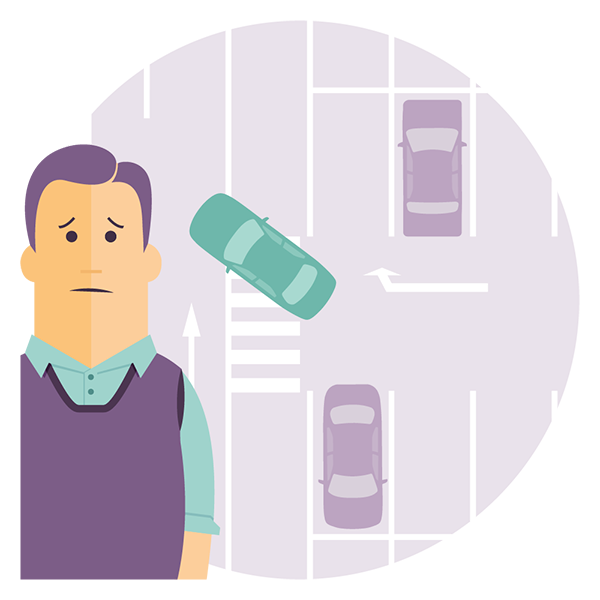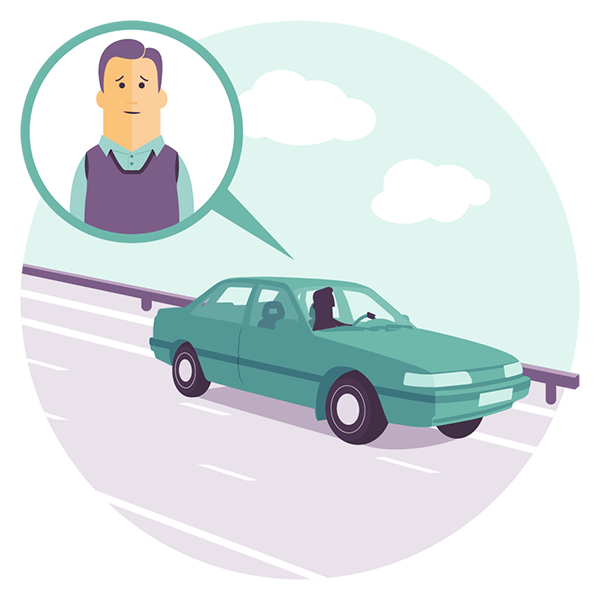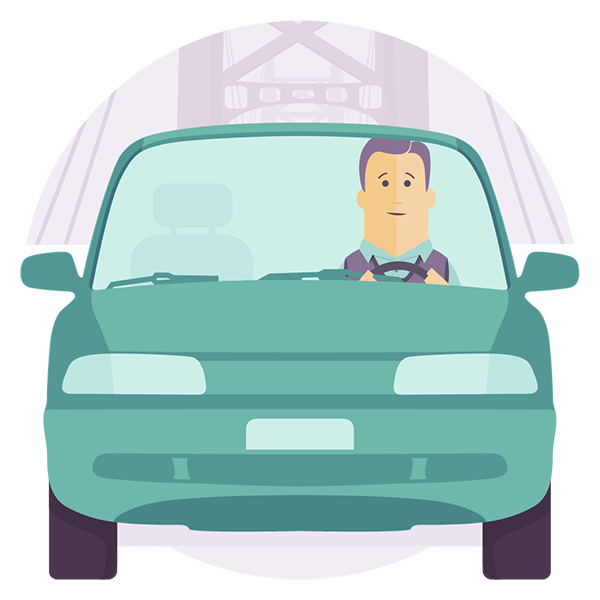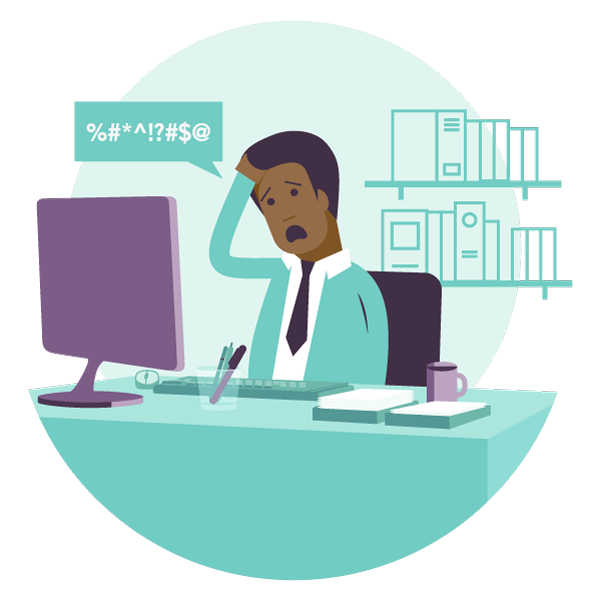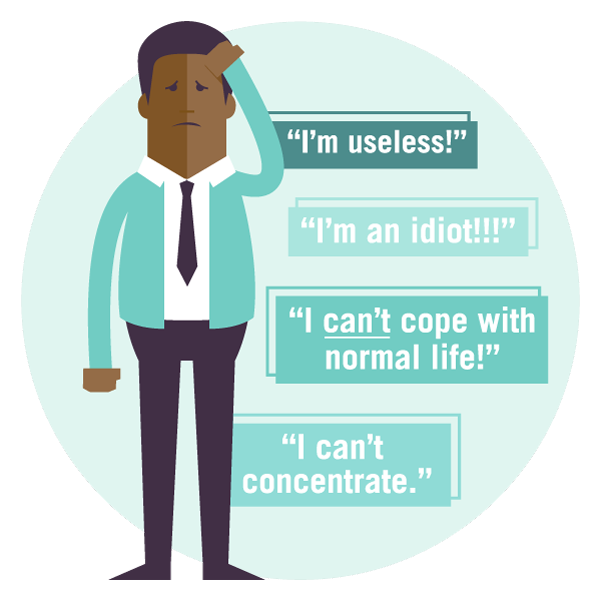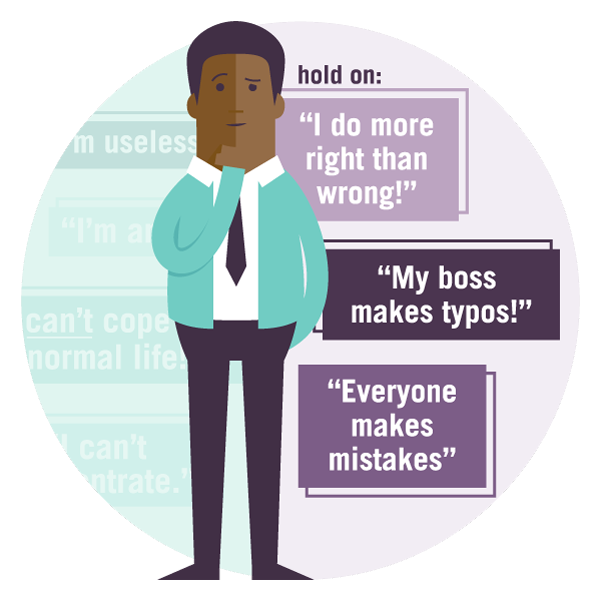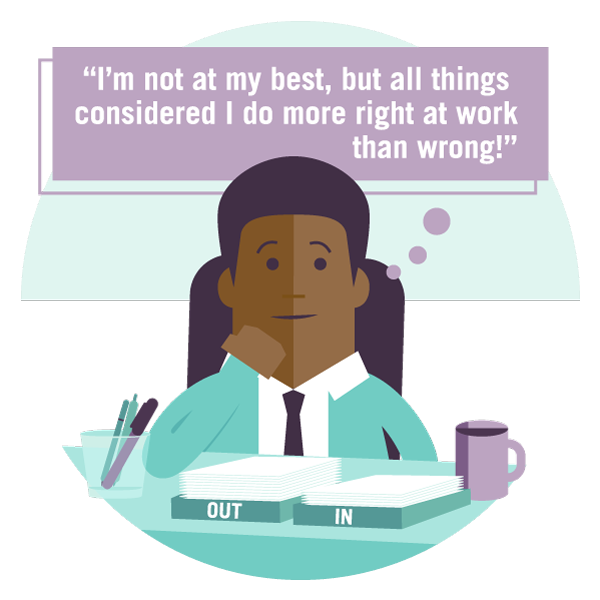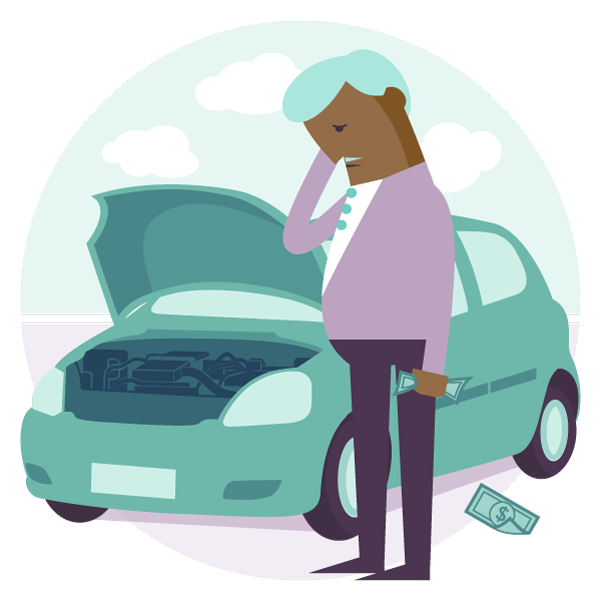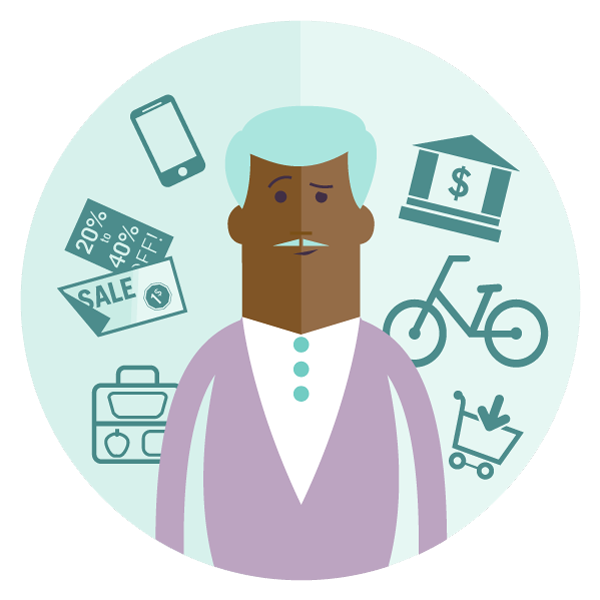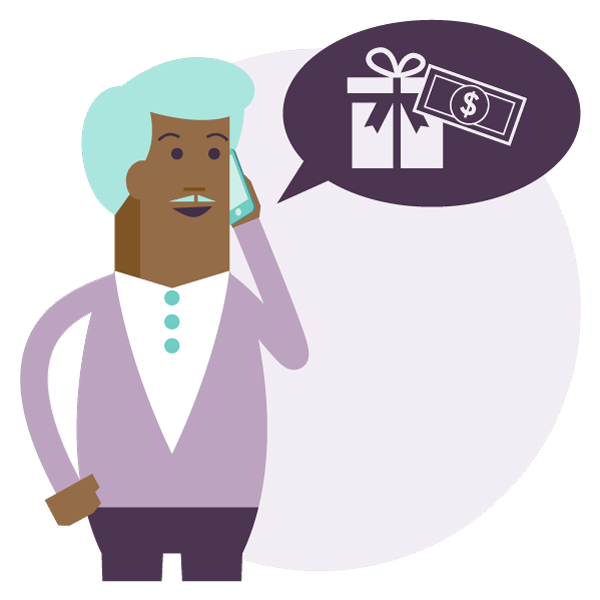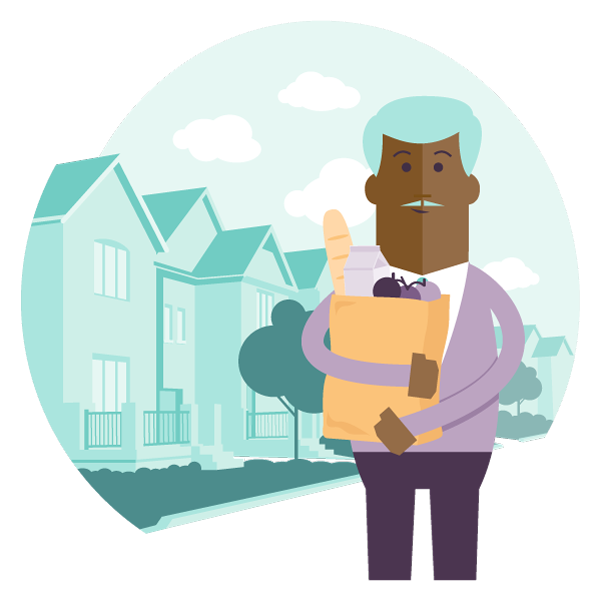Panic
Panic is common and can affect anyone. The good news is that there are effective treatments that can help. Here you will learn more about panic and how to treat it.
You can use any lesson at any time. However, therapy for panic usually uses this order:
Learn the facts about panic -- what it is, what it feels like and most importantly, how it's treated.
Learn how to handle the physical symptoms of panic. As your tolerance increases, your panic attacks will lose their power.
Learn how to deal with situations in which panic attacks may occur. As you cope with more difficult situations, panic attacks will lose their power.
In this unit, you will learn how you can feel better by challenging the thoughts that bring you down.
Anxiety creates muscle tension and makes it hard to relax. Learning to relax is a skill that will help you reverse the cycle of anxiety.
When you've got a problem, you need to do more than challenge negative thoughts. Here you'll learn how to cope in these situations.
Learn about the types of medications used to treat depression and anxiety.
Keep practicing. Download reusable worksheets and other tools to keep you going.
What is Panic?
5minIt’s normal to feel panic when you are in danger. But when panic starts to interrupt your normal routine it can take over your life. People who suffer from panic attacks can experience intense physical sensations. These attacks can happen at any time, like before bed, at the store or while taking a shower. Luckily, there are effective treatments for panic! You can regain control and get back to the things you care about.
- The Facts
- Fear and Panic
- The Symptoms
- Treatment
! For your privacy, this site does not save what you type. To save it or have a therapist review it, please download your work at the end of your session.
The Facts
It’s Common
Panic is common and can happen to anyone. It may be surprising, but about 70% of people have at least one panic attack at some point in their lives! Panic attacks become a recurring problem for about 1 in 30 people.
It’s Treatable
You might feel hopeless and believe that your panic attacks are incurable. But treatment for panic really works! People who receive cognitive behavioral therapy for panic have great results. About 90% report that they still have not had a single panic attack 1 year later!
Fear and Panic
If you were nearly hit by a car while crossing the road you might feel some quick changes in your body. Your heart might start racing. You might begin shaking and feeling dizzy, hot or nauseous. You might feel pain in your chest and find it hard to breathe. You might feel panicked and afraid.
When a person experiences fear, their body is sending out a signal to “get ready.” It’s like an alarm. Your body has sensed some kind of danger, and it’s “mobilizing the troops” to either fight or run. This could happen while facing a wild animal or while driving in bad weather.
You may have noticed that your body can get ready for danger even when there’s no threat. For example, have you ever jumped out of your seat while watching a movie? Do some scary memories still make you tense? This means that you don’t need to be in real danger to feel fear. You can feel it just by imagining that something is dangerous.
When Panic Becomes a Problem
Panic becomes a problem when your alarm keeps going off. In a way, it’s like a false alarm, like when your smoke detector goes off but there’s no fire. Panic attacks create the same intense fear you’d have in any dangerous situation. The difference is that they happen at times when most people would not feel afraid. It may seem like panic attacks can hit you out of the blue, anytime, anywhere.
A panic attack can be very uncomfortable and scary if you do not understand what is happening or why. You may start to worry that these attacks will damage your body or ruin your life. You may be afraid of having another attack all the time, no matter where you are or what you’re doing. These worries and fears can make you hyper alert. You may start scanning your body all the time, looking for early signs that a panic attack is coming. You may see even small changes in your body as a sign of an attack. As your anxiety builds up, you may have a panic attack because you are so afraid of having one!
With time, you may start avoiding places and situations where a panic attack could occur. Now your fear that panic will take over your life is coming true! Your panic attacks may now seem even scarier. Again, this makes your anxiety go up, making it more likely that you’ll have more attacks.
Physical Symptoms of Panic
When you start to panic, your body will start feeding more oxygen to your muscles to help you deal with danger. You may feel your heart racing as it pumps blood and oxygen faster through your body. Your muscles may tense and you might start to breathe faster. Blood will move from your hands and feet to your lungs, heart, and muscles. Your hands and feet may start feeling cold, tingly or numb.
Your body will also prepare to scan for danger. Your pupils may get bigger to take in more information. Your hearing may become more sensitive. You may sweat more to cool your body down and make you slippery for attackers. You might have an upset stomach as your body stops processing food.
All these physical changes are perfect for fighting or running from danger. But when there is no threat to run from, your body starts to fill with too much oxygen. This can make you feel dizzy and disoriented. You might even feel like the world is becoming less real. You might start to shake or tremble and experience muscle and chest pain. As the attack continues, your body will become exhausted from maintaining such alertness. Eventually, the panic attack will die down because your body is too tired to keep it up.
It’s important to remember that while panic attacks feel terrible, they aren’t dangerous. This is simply your body’s natural reaction to danger, even if it’s a false alarm.
Please note that the physical symptoms of panic can also happen for other reasons. It’s important to make sure your symptoms are from panic and not something else. See your family doctor or healthcare professional for a proper check up.
Other Symptoms of Panic
Most people only think about the physical symptoms of panic, but it can also affect you in other ways.
During a panic attack, people often worry that they are dying or going crazy. You may have a sense of doom as if something terrible is about to happen. Your thoughts may go "blank." Over time you may worry that your panic attacks will never stop and see yourself as weak.
During a panic attack, you may cry, become shaky or have trouble speaking. You might rush out of the room and try to hide. Over time, people with panic often start avoiding situations that they fear. This can include places where they've had a panic attack before or where they think one is likely. You may also try to ensure that you can quickly escape or get help if you need it. Some people never go out alone, always sit close to an exit, or avoid peak times for transit or shopping.
Panic attacks can trigger a range of emotional reactions. These can include fear, shame, embarrassment, and helplessness. You might feel "spacey," like things are surreal or dream-like. It is common to feel frustrated, or even hopeless, about the panic attacks ever stopping. If panic goes on long enough, people can also become sad or depressed. If you start avoiding places out of fear of having an attack, you can also start to feel lonely and isolated.
Treatments
The good news is that panic can be treated! Different kinds of therapy and medications can get you feeling better:
There are many types of psychotherapy or talk therapy. Kelty's Key is based on cognitive behavioral therapy. This method teaches you how to handle the physical symptoms of panic. As your tolerance increases, your panic attacks will lose their power over you.
Different medications can be used to treat panic. It's important to know that some medications are not long term solutions for panic. You should discuss the options with your doctor. It can take time to find the best medication for you.
Well Done. You’re on Your Way.
You’ve taken the first step and learned about panic. Knowledge is important. Understanding what panic is and how it works will help you moving forward.
Facing Physical Sensations
12minYour body has strong physical reactions when you have a panic attack. Your heart may pound and you might begin to shake. You might feel pain in your chest and find it hard to breathe. A vicious cycle can start when you believe these sensations are dangerous. You become hyper aware of every new physical sensation that might signal an attack. When you are always on edge, scanning your body, you increase the chances of having another panic attack. To break free from panic, you need to learn not to be afraid of your physical symptoms. When you learn that these symptoms are not harmful, your attacks will lose their power.
- The Panic Cycle
- Learn by Exposure
- Exposure Exercises
- Reflect and Practice
! For your privacy, this site does not save what you type. To save it or have a therapist review it, please download your work at the end of your session.
The Panic Cycle
We’re not going to lie. Panic attacks feel terrible. When you have a panic attack, you may worry it will cause you to faint or damage your heart. It’s no wonder that so many people try to avoid uncomfortable physical symptoms.
To “stay safe” many people take steps to prevent certain physical symptoms. You might stop exercising because it makes your heart race. A necktie or tight sweater might make you feel like you can’t breathe. It’s also common to start scanning your body for early signs that an attack is coming.
The more you become hyper alert to physical changes in your body, the more your anxiety can increase. Because you are so afraid of having more attacks, you may see even tiny changes in your body as signs that one is coming. You can start to have panic attacks because you’re so scared of having one! In effect, you are causing what you meant to avoid. It’s a nasty cycle that makes your panic attacks more and more frequent.
The easiest way to break this cycle is to challenge your initial belief. It may be surprising, but panic attacks are not dangerous! They might feel scary and awful, but they won’t harm you.
Exposure: Learn Through Experience
The key to overcoming panic is learning that its physical symptoms are harmless. For some people, just reading this fact is enough for them to break the cycle. If not, a little practice will be your best teacher. We don’t need to tell you panic is harmless, you’ll see for yourself!
This exercise is called exposure. The main idea is to bring on the symptoms of panic on purpose. You might make yourself dizzy or force yourself to hyperventilate. It may sound scary, but it’s an important learning experience. The more you expose yourself to panic sensations, the easier it will be to see that they are not dangerous.
Your Panic Symptoms
Before you can start an exposure exercise, you need to identify what you feel during a panic attack. Different people will be aware of different symptoms. Some might scare you more than others. A racing heart may terrify you if your family has a history of heart problems. If you feel dizzy, you may worry you’ll faint while driving.
What do you feel during a panic attack? Which symptoms are most upsetting to you?
Select all that apply:
Your Thoughts While in Panic
During a panic attack, your thoughts can change as much as your body. It’s common to have intense, extreme thoughts like “I’m dying!” or “I’m going crazy!”
Even though these thoughts are normal, they can make your panic worse. Your body and mind work together. A thought like “I’m dying!” will increase the feeling of threat. Your body will respond by boosting the physical symptoms of an attack. It’s part of the panic cycle. The more you think you’re dying, the more you’ll feel like it. And the more you feel like it, the more you’ll believe it. You may need to keep track of your thoughts and challenge them after an exposure exercise.
What kinds of thoughts do you have during an attack?
Select all that apply:
Try Hyperventilating
Many of the worst symptoms of panic are caused by breathing in too much oxygen. When you take in more oxygen than you use, you may feel dizzy, breathless or disoriented. For this reason, hyperventilating is one of the best exposure exercises for panic.
If you are nervous, you can start doing this exercise with someone else around. For example, you might ask a friend to be present. You can also keep an object nearby, like a phone or lucky charm, that makes you feel safe. With time, however, you want to experience the full effects of the exercise on your own. This way you will truly learn that hyperventilating is safe.
Before you complete this or other exercises, you want to confirm that it is medically safe for you to do so. First, consult your doctor if you have any other significant health issues. If you are pregnant or have seizures, you should avoid this exercise.
Dr. Christine Korol guides you through a hyperventilation exercise. Once you have started, do not stop until the end. Don't do anything that distracts you from the panic sensations. Dr. Christine Korol will hyperventilate with you for 1 minute.
Time to Reflect
Take a moment to think about your experience.
How did you feel during this exercise?
What were your thoughts during the exercise?
What did you learn?
Exposure to Other Sensations
Hyperventilating can create a lot of different sensations. You may find that it is the only exposure exercise you need. If not, there are other exposure exercises you can try. These can target other physical symptoms like shaking or nausea. Here are a few examples.
| Symptom | Exercise |
|---|---|
| Choking | Place a tongue depressor at the back of your tongue for 30 seconds |
| Dizzy/Faint | Spin around while seated on a rotating chair for 1 minute. Or spin on the spot at a medium pace. |
| Feeling Unreal | Stare at yourself in the mirror or at a spot on the wall for 2 minutes. |
| Heart Racing | Run on the spot for 1 minute. |
| Trembling/Shaking | Tense the muscles in your body as tight as you can for 1 minute. |
Practice and Repeat
It’s important to keep practicing your exposure exercises. As you continue to do them, your tolerance of the sensations will go up. You’ll start to notice that you can cope with the symptoms of panic better than you thought possible. With practice, panic attacks will become less scary when you know you can handle the symptoms. Without a fear of panic, your attacks will be less likely to happen in the future.
Don’t expect the symptoms of panic to ever feel enjoyable! They may always be uncomfortable, but you can learn not to be afraid of them. You want to continue practicing exposure until the sensations no longer scare you.
When you practice exposure, remember these tips. Always finish an exercise completely. Don’t stop part way through. Slowly work towards doing the exercises by yourself. Stop using objects that make you feel safe. Keep note of what you learn over time. It can be helpful to plan days and times to do your exercises. It will also help to keep track of your progress.
Simone's Story
Good Job! You've Started to Face Panic Sensations!
Download Your Worksheet
Good job! You've started to expose yourself to the physical sensations of panic. If you have any concerns about some of the physical symptoms of panic not discussed, talk to your therapist. Many people find it scary to start exposure exercises. Remind yourself that exposure is an important part of treatment. With time, your tolerance for the sensations of panic will build. Your panic attacks are likely to diminish when you are less afraid of the symptoms. Keep practicing your exposure exercises. Download your worksheet to keep track of your progress.
Taking on Tough Situations
15minSymptoms of panic can feel so awful that you might start to avoid situations that feel risky. The difficulty with this plan is that avoidance tends to grow. Panic starts taking control over more and more areas of life. Here you’ll learn how to do the opposite! You can use simple skills and strategies to expose yourself to panic in a safe and gentle way. Exposure is key to overcoming panic!
- The Avoidance Cycle
- Exposure
- A Series of Goals
- Keep Practicing
! For your privacy, this site does not save what you type. To save it or have a therapist review it, please download your work at the end of your session.
The Avoidance Cycle
When you start to feel panicky, there are strong changes in your body, your thoughts, and your emotions. These changes can feel uncomfortable, and they can remind you of a bad experience such as a panic attack.
It’s human nature to try to avoid things that feel bad or uncomfortable. Nobody wants to feel that way! So if you had a terrible panic attack in a store, it’s likely you wouldn’t want to go there again. Even the thought of going near it might cause your chest to feel tight.
Avoiding things that make you feel panicky might seem like a good strategy, but it does more harm than good. The problem with avoidance behavior is that it strengthens the thought “I can’t.” When you tell yourself “I can’t go there,” or “I can’t handle it,” you’re reinforcing these beliefs. As you begin to believe that “you can’t,” your mind gets caught up in a cycle. You’ll start to avoid more and more situations, as your world becomes smaller and smaller. In this way, some people eventually become unable to leave their homes.
Exposure: Overcoming Avoidance
One of the best ways to treat panic is to overcome avoidance with a tool called exposure. This technique involves facing what you have started to avoid. The idea is to expose yourself to uncomfortable situations in a safe and gentle way. Your experiences will be your teacher. With time, you will see that you are better at coping with tough situations than you thought. Exposure is a tool that helps you flip the “I can’t” back into “I can.”
Exposure will also help you reduce your dependence on things that make you feel safe. These can be the presence of other people or objects. It can also be behaviors, like looking away or breathing quickly. Some people use alcohol or substances to numb the experience. You will learn that you can cope without having these things around. Your experiences will be your proof. Over time, panic will lose its control over your life.
Your Difficult Situation
The first step of exposure is to identify a situation or thing you avoid. It could be something like crowds, going to a restaurant or giving a presentation. You may avoid a few different things or situations. In that case, start with the one that feels the easiest. For example, you might want to work on eating at a restaurant before giving a presentation.
Name a situation or thing you'd like to stop avoiding:
Create a Series of Goals
Exposure doesn’t mean you have to jump into the deep end. It’s better to go slow. Work in steps. Create a series of smaller goals to help you slowly build up to your ultimate objective. Let’s say you want to be able to take the train to work. You might start out with just getting the train schedule. From there you might buy a train ticket or ride the train one stop with a friend. As your confidence builds, you can work up to your ultimate goal of riding the train by yourself to work.
If you are unsure how to break your goal down, think about how you could change the conditions to feel better. Consider who you’ll do your exercise with, how long you’ll do it for, and what time you’ll do it. For example, suppose your ultimate goal is to eat dinner at a restaurant. You could go to a restaurant with a friend before trying it alone. Eating out at 3:00 pm might be less stressful than at 7:00 pm or the evening rush. You could also go for a quick coffee or dessert before you go out to have an entire meal.
Some people use safety behaviors to ease into exposure. These can include using certain objects, like your phone or a water bottle, that make you feel more at ease. You might start out by sitting near the exit, carrying a lucky charm or having some medication on hand. But you can’t shield yourself forever! Eventually, you’ll need to cut out these safety behaviors to truly face your fear. It’s the only way to reach your ultimate goal.
Your Goals
My Ultimate Goal:
Write out a few different ways that you can expose yourself to your situation or thing. Start with your easiest goal and gradually work up to the hardest.
Your First Exposure
Good job. You’re ready to start planning your first exposure exercise:
asd
How anxious do you feel about trying this exercise?
When will you do your exercise?
How long will you do your exercise for?
Keep Track
Once you complete an exposure exercise, it is important to keep track of your experience. You can write down how your body felt and what you were thinking during the exposure. It’s also a good idea to keep a note of what you learned from your experience. You may have found a good coping strategy. For example, it may have helped to remind yourself that panic attacks are not dangerous. Perhaps talking back to your negative thoughts helped you stay calm. You should also rate your anxiety from 0 to 10 after the exercise. These ratings will help you see your progress.
Practice and Repeat
It’s important to keep practicing your exposure exercises. Continue repeating an exercise until it no longer causes you stress. Then you can move up to the next goal on your list. If you are unsure whether you are ready to move on to another goal, talk to your therapist. You can also look at your anxiety ratings over time to see how you’ve progressed.
You need to keep practicing exposure until you reach your ultimate goal. Once you feel comfortable in one situation, like riding the bus, you can work on others like driving. It may take a while to complete, but it is an important part of your treatment. Celebrate each success along the way!
When you practice exposure, remember these tips:
- Always finish an exercise completely. Don’t stop part way through.
- Slowly work towards doing the exercises by yourself. Once you are on your way, stop using objects that make you feel safe from panic.
- Keep note of what you learn over time. Review what you learned in previous exercises before doing a new exposure.
- It is helpful to plan days and times to do your exercises.
- It will also help to keep track of your progress.
- Don’t forget to celebrate your achievements as you move through your series of goals!
Peter's Story
Good Job! You've Started to Take on Difficult Situations!
Download Your Worksheet
Good job! You've started to expose yourself to difficult situations related to panic. Many people find it scary to start exposure exercises. Remind yourself that exposure is an important part of treatment. Keep practicing your exposure exercises. Download your worksheet to keep track of your progress.
Thought Challenging
20minFew things in life are as important as talking to yourself kindly. If you want to achieve a goal or live a happy life, you need to talk to yourself like you are your own best friend. It’s hard to stay motivated or positive if we are too critical or feeling hopeless about a situation. When everything feels like too much, negative thinking can become routine and get in your way. In this unit, you’ll learn how to break the cycle and challenge the thoughts that keep you down.
- Keep a Thought Diary
- Track Unhelpful Thoughts
- Find Evidence
- Balance Your Thoughts
! For your privacy, this site does not save what you type. To save it or have a therapist review it, please download your work at the end of your session.
Different Perspectives
Most people believe their feelings are the result of what happens to them. If you failed a test, had a fight with your best friend, or you lost your wallet — you’re going to feel bad, right? But not everyone will react the same way, even in a tough situation. Thoughts like “I’m such an idiot” will make you feel worse, while thoughts like “I’ll do better next time” will make you feel a bit better. In the end, it’s our thoughts about things or events, not our situation, that determine how we feel.
Why Challenge Thoughts?
When you’re worrying or feeling down, most people will tell you to “let it go.” The problem is that’s easier said than done! The only way to let go of an unhelpful thought is to challenge it enough that you no longer believe it. If you try to force yourself to think, “It’s all going to be okay,” when you don’t believe it, you’ll feel worse.
Keep a Thought Diary
Sometimes, thoughts can come so quickly that you don’t notice them. The best way to track these sneaky thoughts is to keep a thought diary. Act like a detective. Keep track of the feelings and thoughts you experience in specific situations. It is important to track the strength of your feelings too. Your therapist can help you identify some of your unhelpful thoughts if you are feeling stuck.
A thought diary looks something like this:
| What was happening? | Feeling and Strength | Thoughts |
|---|---|---|
| I was sitting on the couch watching TV. | Sad → 60% Anxious → 40% Disappointed → 80% |
“Will I ever get better?” “What’s wrong with me?” |
Start a Diary
Pick a situation that is troubling you right now. It may be something that just happened a moment ago. It could be something that happened in the past but still continues to bother or worry you.
What was happening?
Remember that the situation doesn't have to be the cause of your feelings. Sometimes an event causes a big reaction, like getting fired. Other times your feelings and thoughts aren't related to what you're doing. Like if you started to cry while taking a shower. You can use a thought diary for any type of situation.
Your Feelings
How do you feel right now when you think about that situation?
If it is a past event, don’t try to remember how you felt then. How do you feel at this moment when you reflect on the situation?
Select up to 5 feelings:
Rate Your Feelings
Now rate how strong your feelings are from 0-10. Remember to focus on the feelings you have right now, not during the event.
We’ll keep track of how strong your feelings are after challenging your thoughts too. This will help us see if the exercise is helpful.
Your Thoughts
What is going through your mind right now when you think about this situation?
If you’re feeling stuck, ask yourself these questions:
What does this say about me? My future? Why does this situation feel difficult? What does this say about others?
Keep Using your Diary
Good job! You’ve started to use a thought diary.
Just recording your situations, feelings and thoughts can take practice. It’s okay if you don’t feel ready to start challenging your thoughts. Keep practicing with your therapist and come back when you’re ready.
If you’ve got the hang of keeping a thought diary then it’s time to start challenging your thoughts. Keep going!
Pick the Most Unhelpful Thought
It’s common to have many thoughts about a situation. Pick the thought that causes the most trouble, anxiety or sadness. You’ll work on challenging this one thought for the rest of the exercise.
Sometimes thoughts don’t work well in thought challenging. Use these tips to pick a suitable thought:
Make sure your thought is connected to one of your feelings about the situation. If the thought makes you feel sad, angry or some other emotion, it's a good thought to choose.
Choose a thought that is testable. If your thought starts with “What if” then you can't prove it true or false. These thoughts are not good for thought challenging.
Here are your thoughts. Which would you like to challenge?
Rewrite the thought you’d like to challenge and “let go” of.
Evidence for the Unhelpful Thought
Do you have any evidence that your thought is true? For example, if your thought is “Jim is mad at me,” your evidence might be that he didn’t return your call. Maybe the email he wrote you seemed cold.
People sometimes realize that they can’t find any proof to support their unhelpful thought. You might think it, but there are no facts that make it true! That makes it easier to let it go.
What evidence do you have that your unhelpful thought is true?
Challenge the Thought
It is almost impossible to let go of a thought if you still believe it! The best way to get rid of a thought is to challenge it until you don’t believe it anymore. To challenge a thought, you must find evidence that disagrees with it. Play devil’s advocate. Look for proof that your unhelpful thought is false or just not completely true.
For example, let’s go back to the thought “Jim is mad at me.” Evidence against this thought could be that Jim smiled at me while saying hello this morning. Sometimes his emails come off as cold when he’s busy.
Challenge your Unhelpful Thought
Here's your unhelpful thought:
What evidence do you have that this thought is not completely true? Include everything you can think of even if it seems too small to mention.
Balanced or Helpful Thoughts
Forcing yourself to think happy thoughts won’t make you feel better. If you don’t believe a positive thought is true, it could make you feel worse. The trick to feeling better is to find a balanced or helpful thought. These thoughts take both the positive and negative evidence into account. Balanced thoughts are more encouraging and supportive than positive thoughts.
Here are some examples comparing positive versus helpful thoughts:
| Positive Thoughts | Balanced or Helpful Thoughts |
|---|---|
| I’m a great friend. | I’m not perfect but I am a good friend. I may not always be there for my friends, but I know that this will get better as my mood improves. |
| I can do anything if I put my mind to it – including getting over my problems! | It might take some practice, but I feel a little more hopeful that I can feel better by changing how I talk to myself. |
| Everybody in my life is supportive and helpful. | I’m getting better at knowing who to count on in my life. I’m not 100% confident, but I’m willing to practice trusting a few people who I think are nice. |
Your Balanced Thought
Take a look at your positive and negative evidence:
Use this evidence to help you make a new balanced thought. If you’re feeling stuck, don’t worry. Balanced thinking can be tricky and your therapist can help you get the hang of it.
Re-rate Your Feelings
Now that you have worked on your balanced thought, take a moment to re-rate your mood. We can compare the strength of your feelings before and after thought challenging. A drop of at least 2 or 3 points in at least one of your emotions tells us that the exercise was helpful.
Practice Makes Perfect
Thought challenging is one of the harder things to learn in cognitive therapy. Remember that it does get easier with practice and help from your therapist. Most people find after practicing 50 or more times that they have fewer unhelpful thoughts. Also, balanced thinking becomes more automatic. Challenging your thoughts 50 times might seem like a lot, but you’ll get faster at it the more you practice.
Sean's Story
Don’t remove
Good job! You’ve Created a Thought Record
Download Your Worksheet
Good job! You’ve learned how to make a thought record and challenge unhelpful thoughts. If you’ve been hard on yourself or thinking unhelpful thoughts for awhile, it can take some work to break that habit. The more you practice thinking balanced or helpful thoughts, the more natural it begins to feel. Try challenging a few thoughts a day and share them with your therapist who can help you tweak them until you don’t believe them anymore. If you have a few unhelpful thoughts that keep creeping back, it’s a good idea to write down a few balanced thoughts or responses on a card to keep as a handy reminder.
Relaxation
15minWhen you become anxious, your body gets ready for conflict. You breathe faster and shallower to take in more oxygen. Your muscles tense as your body gets ready to fight or run. When you are worried about something that might happen in the future, your body can stay tense for a long time. This can make your muscles hurt and feel sore. You may end up feeling exhausted and more anxious. Learning to relax can help you break this vicious cycle. You need to give your body and mind a rest.
- The Skill of Relaxation
- Deep Breathing
- Progressive Muscle Relaxation
- Overcoming Obstacles
! For your privacy, this site does not save what you type. To save it or have a therapist review it, please download your work at the end of your session.
Muscle Overdrive
If you came face to face with a wild animal, your body would get ready to either fight or run away. You would start breathing faster and your heart would start pumping like crazy. Your muscles would tense up, like a sprinter getting ready to run. When the danger was over, and you’d escaped, your body would calm down and go back to normal.
When you’re worried about something, your body gets ready in the same way. The difference is that you aren’t in danger. There’s no wild animal in front of you. Instead, your body is preparing itself for a wild animal that you might confront some time in the future. Because you can’t escape from a “what if”, your body doesn’t get to calm down and relax. You can stay ready for danger for a long time and send your muscles into overdrive. Learning to relax can help you give your body and mind some rest.
Relaxation as a Skill
Some people think that relaxation should be a natural process. “I’ll just sit down on the couch, turn on the TV, and do nothing.” But you might find that relaxing is actually harder than you think. Some people find that their worries take over when they try to relax. They might even feel guilty that they aren’t doing errands or taking care of things.
Learning to relax is a skill. It might not be enough to just distract yourself with a TV show or a hobby. Instead, you might need to practice specific ways to focus on relaxation. These techniques can help give you a break from the way anxiety affects your body. They can also teach you how to deal with worries that might come up when you’re relaxing.
When to Relax
A lot of people think you should relax when you are very anxious. But it’s really hard to relax when you are at the height of panic or worry. In fact, research shows that trying to relax during these stressful moments doesn’t work. It can actually make your anxiety worse!
Relaxation is not good for emergencies. You can’t relax away the intense physical symptoms of anxiety. Instead, you should practice relaxation regularly at times when your anxiety is under control. Make it part of your self care routine. With practice you can do relaxation exercises throughout your day. You can practice on the bus, at work or before you go to bed.
Types of Relaxation
There are lots of different ways to relax. Some focus on your breathing, others focus on your muscles. You might find that some techniques work better than others. Everyone is different. What works well for you might not work at all for someone else.
We’ll focus on two different ways to relax: Deep Breathing and Progressive Muscle Relaxation.
Deep Breathing
Babies breathe in a slow and deep way. As life becomes more stressful, people’s breaths tend to get quicker and shallower. This becomes a habit unless people learn to revert back to deep breathing. Some people master how to do this when they learn to sing or do yoga.
You can check your own breathing style by placing one hand on your chest and the other on your stomach. When you breathe in, notice which part of your body rises the most. If it’s your chest, focus on slowing down and deepening your breath. You want to arrive at the point where your stomach expands, but your chest barely rises. You also want to aim for about 8 seconds between in-breaths. Make sure to also slow down your out-breath to about 4 seconds.
Practicing Deep Breathing
You can practice deep breathing anywhere! It’s invisible to the people around you. You can practice while waiting in line, on the train or at the movies.
In the beginning, you can practice deep breathing for only 5 minutes at a time. As you progress, you can start using it anytime and anywhere you have a few moments to spare.
You can also use this technique when you notice that your breathing has become fast or shallow. Slowing your breathing sends a message to your brain that there is no danger. This allows your body to take a break and can reduce your fatigue over time.
Progressive Muscle Relaxation
This relaxation technique focuses on your muscles. The idea is to squeeze your muscles tight and then relax them. It might sound strange to tense up your muscles first, but this can make the relaxation feel deeper. Think of it working like a rubber band. The more you pull it tight in one direction, the further it snaps back in the opposite direction.
Progressive muscle relaxation can help you become more aware of your body. People often keep their muscles tight without noticing it. You might be tense even when you aren’t worrying! As you practice relaxation you’ll get better at recognizing the state of your muscles. Once you notice your anxiety and tension building up during the day, you can take steps to relieve it.
Practicing Muscle Relaxation
There are many different muscle groups where you may store tension. You shouldn’t try to squeeze all the muscles in your body at once! To do progressive muscle relaxation you need to work through the muscle groups one at a time. You can do it in any order. We’ll start from the head down to the toes.
Facial Muscles
Forehead
To tense the muscles in your forehead, lift your eyebrows up as much as you can. This should cause your forehead to wrinkle. Feel the tension in your forehead and scalp. Hold it for 5 seconds, then let go. Notice how the muscles relax when your eyebrows drop.
Eyes
Close your eyes and squint them as much as you can. At the same time, wrinkle your nose. Focus on the tension around your eyes, nose, and cheeks. Hold it for 5 seconds. Then stop squinting and wrinkling your nose, while keeping your eyes closed. Feel how the muscles around your eyes, nose, and cheeks relax.
Jaw
Make a big grin and clench your teeth. Also draw your mouth and chin inward. You should feel your mouth, jaw, and neck tense. Hold it for 5 seconds, then let go. Focus on how your jaw muscles and neck muscles relax.
Practicing Muscle Relaxation
Upper Body Muscles
Shoulders
Move your elbows up and back so that your shoulder blades gets pushed together. Focus on the tension this creates in your shoulders and back. Hold the tension for 5 seconds. Then relax your elbows and shoulders and focus on the relaxed feeling in your shoulders and back.
Chest
Take a deep breath and hold it in by tightening your chest. Focus on the tension in your chest as you pull it in. Hold the tension for 5 seconds. Then breathe out slow and focus on the looseness of the chest muscles.
Upper arm
Start with your dominant arm. Tense your bicep while keeping your forearm relaxed. You could also press your bicep into the side of your body. Focus on the tension in your upper arm. Hold the tension for 5 seconds. Then relax your arm and focus on the relaxed feeling in your upper arm. Now repeat this with your other arm.
Lower arm
Start with your dominant arm. Tense your forearm as much as you can. Make a tight fist. Keep your upper arm relaxed. If you have arthritis in your hands, make sure you do not keep your fist so tight that it hurts. Also if you have long fingernails, do not dig them into your hands. Focus on the tension in your hand and forearm. Hold the tension for 5 seconds. Then relax your forearm and hand and focus on the relaxed feeling in these body parts. Now repeat this with your other arm.
Stomach
Tighten your stomach muscles. Make them as hard as possible. Focus on the tenseness of these muscles. Hold the tension for 5 seconds. Then relax your stomach muscles and focus on how they change from tense to relaxed.
Practicing Muscle Relaxation
Lower Body Muscles
Buttocks and Thigh Muscles
Tighten your buttocks by squeezing them together as much as you can. Focus on the tension in your gluteal and thigh muscles. Hold the tension for 5 seconds. Stop squeezing your muscles together. Focus on the relaxed feeling in your gluteal and thigh muscles.
Calves
Start with your dominant leg. Lift your foot off the floor and point your foot. Tighten your lower leg. Focus on the tension in your foot and calf muscle. Hold the tension for 5 seconds. Then return your foot to the floor and focus on the relaxed feeling in your calf and foot. Now repeat this with your other leg.
Shins
Start with your dominant leg. Lift your foot off the floor and flex your foot. Tighten your lower leg. Focus on the tension in your foot and shin muscles. Hold the tension for 5 seconds. Then return your foot to the floor and focus on the relaxed feeling in your shin muscles and foot. Now repeat this with your other leg.
Overcoming Obtacles
Obstacles to relaxation vary from person to person. But some are pretty common. We’ve got a few tips to help you:
If you have an injury or feel pain for any reason, don't squeeze your muscles too hard. Pain will make your muscles tense up, making it hard to relax. If an area really hurts, skip making it tense and try to relax it directly.
While trying to relax, you may become distracted by worries. Don't try to argue with your worries or push them aside. This will only distract you more. The best approach is to bring your attention back to the relaxation exercise.
If you don't find deep breathing or progressive muscle relaxation effective, don't worry. There are other ways to relax. Ask your therapist for advice.
If you find it hard to stay awake during a relaxation exercise, try sitting up instead of lying down. It can also help to do your relaxation earlier in the day. It's easy to fall asleep if you do your exercise right before bed.
Try a Relaxation Exercise
It’s time to try relaxing! Many people find it useful to follow an audio recording. Everyone does relaxation a little different, so you might prefer some recordings to others. Try them out and see which ones you like.
Dr. Lori Brotto guides you through a body scan focusing on acceptance and awareness. This mindfulness exercise will take about 40 minutes.
Sean Butler leads you through a progressive muscle relaxation exercise. You can complete this practice in just over 11 minutes.
Dr. Theo DeGagne presents Quietude, with music by George Blondheim. This guide takes you through breathing relaxation, deep relaxation, and visualization. This exercise will take you about 20 minutes.
Flora Lung presents Beautiful Beach, a guided imagery relaxation exercise. This exercise is in Cantonese and will take about 20 minutes.
Flora Lung 提供一個啟導式想像鬆弛練習 ----- 美麗的海灘。練習以粵語進行,需時約20分鐘。
Poran Poregbal leads you through a body and mind relaxation guide. You will focus on your breathing, heartbeat, mind and sensations. This exercise is in Farsi and will take about 10 minutes.
پوران پوراقبال راهنمای شما میشود در یک تمرین آرامش یابی بدن - ذهن. شما تمرکز میکنید بر تنفس، ضربان قلب، و هیجانات ذهنی. این تمرین به زبان فارسی است و ۱۰ دقیقه به طول میانجامد
Andrea presents Safe Place, a guided visualization that promotes feelings of safety and comfort. This visualization is in Spanish and will take about 5 minutes.
Andrea presenta Lugar Seguro, una visualización guiada que promueve sentir seguridad y comodidad. Esta visualización es en Español y toma aproximadamente 5 minutos.
Good job! Time to Make Relaxation a Habit
Download Your Worksheet
Good job! You've learned how you can use relaxation to give your body a rest. Relaxation is a skill and the more you practice it, the more effective it may become. We have included a worksheet to record your daily practice of relaxation. Download your worksheet and record your practice for the next week. Share your experience with your therapist or healthcare provider.
Problem Solving
10minIt’s easy to feel overwhelmed when facing a problem like losing your job or a close friend. When you have a problem, changing your thoughts is not the goal; you need to change your situation. In this unit, you will learn how to work through your problems and generate solutions. Take control and create a plan. Even at the worst of times, a good plan will help you get through it.
- Naming the Problem
- Brainstorming Solutions
- Making a Choice
- Taking Action
! For your privacy, this site does not save what you type. To save it or have a therapist review it, please download your work at the end of your session.
Plan to Action
Problem-solving plans are the key to helping you face life’s challenges, big or small. Ignoring your problems doesn’t make them go away — it gives them time to get bigger. Instead, take action and make a plan to help you break down your problem and solve it once and for all. Your plan will also help boost your confidence. When you trust that you can handle whatever life throws at you, you’ll worry less and feel better.
Name the Problem
So how do you make a problem-solving plan? The first step is naming the problem. It’s important to make sure you are dealing with a problem and not a worry. Worries focus on something that might happen. They usually start with the words "what if." Problems are happening right now or about to happen very soon. If you aren’t sure if you have a worry or a problem, ask yourself if it’s already happened. If the answer is yes, you’ve got a problem.
Name the problem. What's going on?
Brainstorm
Once you’ve named your problem, it’s time to brainstorm possible solutions. Try to think up a few ways that you could solve your problem. It’s important not to censor yourself. Write down all your options, even if some seem silly. Sometimes the most ridiculous thought can lead you to the best solution.
If you're feeling stuck, try brainstorming with someone else. Your therapist, a good friend, or a family member can help you come up with ideas.
Try brainstorming three solutions to your problem:
Pros and Cons
Take a look at the different options you came up with to solve your problem. What are the upsides and downsides for each possible solution? For example, if you lost your job you might consider going back to school. An upside could be that it would lead to better job opportunities. The downside could be that tuition is expensive.
What are the benefits of each of your solutions? What are the drawbacks?
| Possible Solution | |
|---|---|
| Possible Solution: 1. | |
| Possible Solution: 2. | |
| Possible Solution: 3. |
Make a Choice
The upsides and downsides of each solution can help you decide what to try first. Take a look at each of your possible solutions and rank them in terms of which you should try first, second and third. There’s no perfect way to rank your solutions. A solution could be ranked first because it’s easy to do, has the fewest downsides or seems the least risky.
Take a minute to order your possible solutions 1, 2, or 3. Which would you like to try first?
| Possible Solution | Order | |
|---|---|---|
| Possible Solution: 1. | ||
| Possible Solution: 2. | ||
| Possible Solution: 3. |
Give it a Try
Now it’s time to give your solution a try! If it doesn’t solve your problem, try another solution on your list or brainstorm some new ones. Depending on the nature of your problem, you might be able to try a few ideas at the same time. For example, if you were looking for a new job you might try a few things right away. You could let your friends know you’re looking, send your resume to a few companies and register with a headhunting agency.
Vijay's Story
Don’t remove
Your Game Plan
Download Your Worksheet
Good job! You’ve got a solution to your problem that you’re ready to try out. If it’s not effective, you’ve got a few backups ready to go. It’s helpful to fine tune your plan with your therapist and keep track of how well your solutions work out. Remember that having a solid plan can help you solve your problems. When you have fewer problems you'll have less stress and more confidence. This will make you feel better and boost your mood. Download this worksheet to save a copy of your plan and keep track of your progress.
Understanding Medication
7minThe use of medication in the treatment of anxiety and depression can be very important. When other types of treatment have not made you feel better, it might be time to try medication. Medication can be used on it’s own or with other treatments, like therapy.
- Why Medication?
- Types of Medication
- Side Effects
- Expectations
! For your privacy, this site does not save what you type. To save it or have a therapist review it, please download your work at the end of your session.
Why Medication?
Doctors use medication to treat anxiety and depression for the same reason they use it to treat many other health concerns. Sometimes, it’s the best way to get the results you need.
Take someone with high blood sugar. They might start by exercising more and changing their diet to try and fix the problem. If this doesn’t lower their sugar levels, their doctor might start them on medication.
The same is true for anxiety and depression. Some people suffer so much that therapy isn’t enough. Perhaps your anxiety or depression is so strong that starting therapy feels too hard to do right now. Medication can help boost your energy and ease your symptoms. Once you are feeling a bit of relief, you’ll be able to focus on therapy and other treatments.
Types of Medication
The same medications are often used to treat anxiety and depression. We can divide these medications into 2 groups: slow and fast-acting.
Slow-acting medications are a bit like vitamins. They take a while to build up in your body, but have a long lasting effect. These medications help restore the balance of the chemical messengers in your brain. Different types work on different messengers. Slow-acting medications are the most common treatment for depression and anxiety.
Fast-acting drugs are like rescue agents. They work right away to help get you through an intense episode like panic. Some people also use them to get to sleep. Fast-acting medications only treat the “here and now.” It is important to note that you can develop a tolerance to some of these medications. This means that over time you might need more of the drug to get the same relief. For this reason, rescue agents aren’t a good long-term solution. But they can help you get through the days or weeks it takes for your slow-acting medication to kick in.
Finding the Right Medication
Our brains are all unique. There is no one medication that works for everyone. One drug might do wonders for you and have no effect on someone else. It’s common to try 2 or 3 different medications before finding the right one for you.
Your medication should improve your quality of life. The benefits should outweigh the negatives. One possible negative is side effects. Antidepressants and anti-anxiety medications can cause dry mouth, stomach aches, dizziness, and headaches. Some might make you feel a bit “off.” Most of the time these side effects disappear after a few weeks. But if they continue, or are too painful to push through, then this medication is not right for you. Some side effects, like increased thoughts of suicide, are very serious, but uncommon.
Talk to your doctor as you begin trying medication. It’s important to find the right drug and the right dose for you. Remember that medication should make you feel better overall, not worse.
Addiction
People often worry that if they start medication they’ll always need it and won’t be able to stop.
Here’s what you need to know:
The slow-acting group of medications do not cause cravings. They are not addictive. But you might feel a bit sick when you stop. For example, you may have bad headaches or dizziness. Going off your medication slowly, in steps, can help avoid these symptoms. Make sure you talk to your doctor.
People can build a tolerance to fast-acting medications. This means you might want more and more of the drug to get relief. Luckily, these medications are not the main treatment for depression and anxiety. It’s important to use these drugs carefully. Take them only when it’s urgent, not all the time.
Length of Treatment
Another concern many people have is how long they’ll need to take medication.
Even if you no longer feel depressed or anxious, you should not stop treatment too soon. It’s recommended that you stay on your medication for 6 months to a year. This will help relieve you of symptoms and stop them from coming back.
If your anxiety or depression keeps coming back, you can stay on medication long term. This is no different from other chronic health issues. Diabetics take insulin daily for life.
Expectations
The main drugs used to treat anxiety and depression are slow-acting. This means you won’t get results overnight! It will take a few days or weeks for you to gradually feel better. Sometimes your friends or family might notice changes before you do.
Medication won’t cure all of your problems. Instead, it will help boost your energy and mood enough to get started. It might make you feel more social or get your appetite back to normal. When you can concentrate and sleep better you’ll be more able to work on your other problems. Medication is a stepping-stone that can give you the push you need to take on other treatments like therapy.
Good Job. You're Exploring Your Options.
When you know what medication can and can't do, it can make a world of difference. Think about whether this is an option you're interested in, and talk to your doctor.
Keep practicing. Download reusable worksheets and audio guides for Panic.
Disclaimer
Please be aware that keltyskey.com does not save your private information. No entries made during this session will be saved. If you’d like to have a copy of your work, you must download your worksheet now.
Would you like to download your worksheet?
We use cookies and similar technologies to operate this site and help us understand how you use it. By continuing to browse this website, you are agreeing to our use of cookies and confirming your review of our privacy policy.

